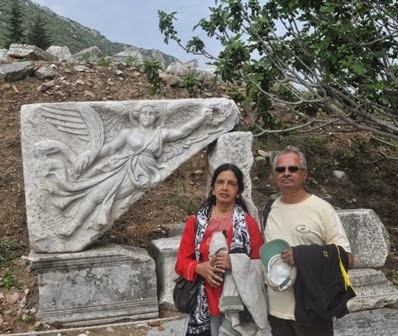LEPAKSHI
The Vijayanagar Empire caused a number of monuments to be built and patronized in the State of Andhra Pradesh. The ornate Lepakshi temples are one of the popular temples of that era. Lepakshi is a small village, which lies nine miles east of Hindupur in Anantapur District of Andhra and is famous for its temple of Veerabhadra, and is also a renowned place where the best specimens of the mural paintings of the Vijayanagar kings are available.
Lepakshi temple is said to have been built by two brothers, Virupanna and Veeranna. The temple was constructed during the reign of Achyuta Devaraya, who ruled the Vijayanagara Empire from 1530 A.D to 1542 A.D Virupanna was favoured by Achyutaraya. During his routine visits he happened to see Papanaseswaralaya on Kurmasaila, (the shape of Kurma the tortoise) which was at that time an insignificant structure. He decided to build a temple on that spot for Veerabhadra,a wrathful manifestation of Shiva, the family deity of Nayak Rulers
For the construction he used funds from the imperial treasury. Virupanna's enemies reported to the emperor that the treasury funds were being embezzled and the treasure was in danger of being exhausted. In those days it was customary to pluck the eyes of the keeper of the royal treasury if he was found guilty of theft or embezzlement. The king ordered that Virupanna should be blinded. Virupanna, being a loyal servant carried out this order on the spot with his own hands and to this day, two dark stains are shown on the west wall of the southern entrance of the inner enclosure, which are said to be the marks made by his eyes which he himself threw at the wall. He did not survive long after this and hence the Kalyanamandapa was left unfinished.
The temple can be divided into three sections- The Mukha Mandapa(also known as Natya Mandapa or ranga Mandapa),The Artha Mandapa and the Kalyana Mandapa. The sculptures seen in the Natya and Kalyana Mandapas are exceptional for their skills and artistic beauty. Most of these sculptures portray mythological figures like Anantha Sayana, Dattatreya, Chaturmukha Brahma, Tumburu, Narada and Rambha. The beautiful sculptures on the prakarams include 14 forms of Shiva, like Dakshinamurthy, Ardhanareeswara,Tripurankara etc. The Natya Mandapa is also adorned with sculptured pillars depicting life size musicians and dancers.
The flat stuccoed granite ceilings provided a suitable background for fresco. The use of natural pigments and ancient mural arts makes Lepakshi remarkable. The birds, beasts and foliage depicted in its paintings and carving have spawned a style often found today in block-printed Indian textiles and rugs, popularly referred to as the Lepakshi motifs.
A wonderful granite bull of gigantic dimensions 6M high and 8m long, a short distance from the temple enclosure is closely associated with Lepakshi in the minds of visitors. It is said to be the largest sculpted Nandi bull in South India, even larger than the famous one on the Chamundi hill in Mysore.

No comments:
Post a Comment